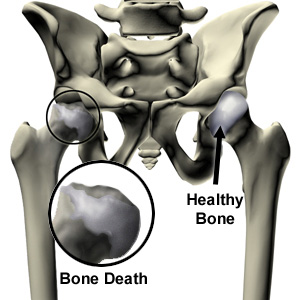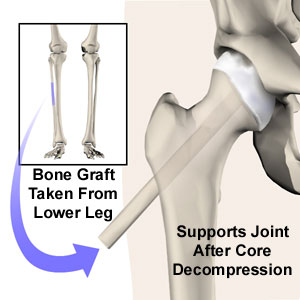|
Osteonecrosis
Written by DynoMed.com,
Indianapolis, IN
Literally, osteonecrosis
means death of bone. It occurs when an area of bone loses its blood supply.
Without a blood supply the area affected will breakdown and collapse in
that area. This process is also called avascular necrosis.

Osteonecrosis affects the hip,
knee and ankle joints in adults. However, osteonecrosis of the hip
accounts for more than 90 percent of all osteonecrosis cases. This disease
may affect one bone or several at the same time or at different times.
Children are also affected but act differently because they are growing
and their bones respond more quickly. This disease primarily develops
in people 20 to 40 years old, with men being more susceptible. The average
age of onset is 38.
Children and
teenagers can develop a form of osteonecrosis called Legg-Calve-Perthe’s
disease. It occurs in the hip or head of the thigh bone (femur).
In osteonecrosis, circulation is lost and bone cells begin to die.
The bones become soft and are prone to collapse under pressure.
Bone tissues break down faster than the body can repair them. If left
untreated, the head of the femur will heal in a collapsed position, leading
to stiffness, pain and arthritis.
Causes
of Osteonecrosis
Osteonecrosis or death of bone may occur after an injury or fracture blocks
the blood supply to an area of a bone. Studies have suggested that this
type of osteonecrosis may develop in about 20 percent of all people who
dislocate their hip joint. Minor injuries will not result in osteonecrosis.
Long-term corticosteriod use may also cause osteonecrosis to form. Corticosteriods
are used to treat inflammation in diseases, such as rheumatoid arthritis.
Doctors are not sure why long-term use of corticosteriod puts people at
a higher risk. If you are concerned, talk to your doctor about your particular
situation.
Excessive alcohol
use is also a common cause of osteonecrosis. Other diseases, such as kidney
disease, lupus and blood disorders, are also risk factors for developing
osteonecrosis. However, in approximately 30 percent of osteonecrosis cases,
the cause is unknown.
Symptoms
of Osteonecrosis
Often a person will experience
little or no symptoms in the early stages of osteonecrosis. Commonly,
the first symptoms felt are pain and aching in the affected joint when
it is being used. In hip cases, the pain will most likely be concentrated
in the groin area. As the disease progresses, pain may be felt even when
the joint is at rest. If it is left untreated and the joint surface collapses,
the pain will most likely increase greatly.
Your doctor will
be able to use x-rays to diagnose the disease if it has progressed beyond
the earliest stages. An x-ray shows the area of the bone that is involved.
Beyond x-rays, your doctor may use MRIs (Magnetic Resonance Imaging) to
look for tissue changes. If necessary, he or she may also order a CAT
scan which is a series of x-rays projected in a three dimensional image.
Treatment
of Osteonecrosis
In order to stop or prevent the breakdown of joints, appropriate treatment
is necessary. If the disease has progressed without detection for a long
period of time, it will be harder to save the joint. If left untreated,
motion will become very difficult and painful. In children, non-weight
bearing may prevent collapse and deformity of the bone but it may take
a few years.
Walkers and crutches
may help when the hip is affected. The use of these assistive devices
may stop the progression of the disease while you consider treatment options.
In most cases, some type of surgery is necessary. Your doctor will first
try to save your original hip but may have to recommend a total hip replacement
if you are an adult.
Experts are currently
trying out ways to encourage the growth of new bone and blood vessels
through medications and combination therapies. At this time, however,
most doctors treat osteonecrosis through surgery.
There are several
surgical treatment options for osteonecrosis, including:
- Core
decompression --This simple procedure works best in cases that
are mild and before the collapse of a joint. A hole is created and a
thin layer of bone is removed. This reduces pressure within the bone
while increasing blood flow to the bone.

- Bone grafting –
After a core decompression, a bone graft may be used to support a joint.
In this complex procedure, healthy bone is transplanted from one part
of the body to the diseased area. The dead bone is removed and a bone
graft is put in its place. Crutches and/or walkers will need to be used
for up to a year to help the healing process.
- Osteotomy
– This uncommon procedure has a lengthy recovery period and is
used in advanced cases and for those patients with a large area of affected
bone. The bone is cut below the infected area and turned so that another
portion of the bone that is not affected by osteonecrosis is the new
weight-bearing area.
- Total hip replacement/Arthroplasty
– If the hip joint is destroyed or the hip socket is affected,
a total hip replacement may be necessary. In this procedure, the diseased
hip joint will be completely replaced with an artificial hip. Once the
disease has progressed to the point the hip socket is affected, a total
hip replacement may be necessary. Different types of hip replacements
are available. You should talk to your doctor about your specific needs.
Only you and your doctor can
determine the best course of treatment for your osteonecrosis after examining
all the options from conservative treatment through total joint replacement.
|

